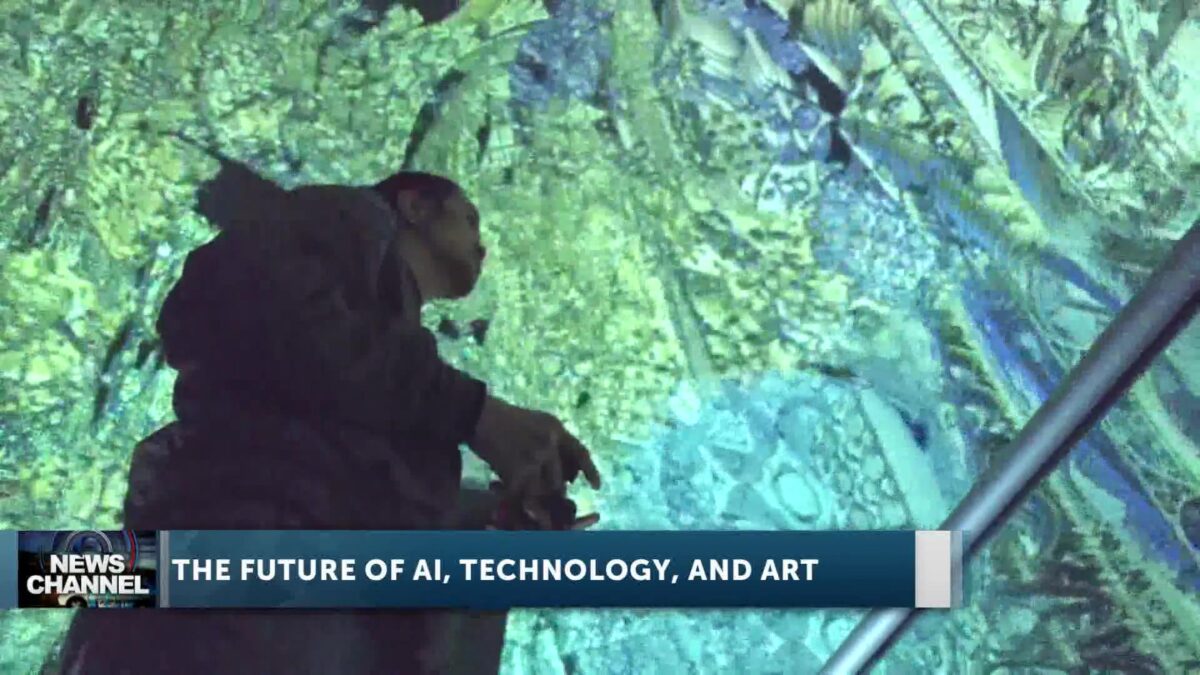AI and Art: Santa Barbara at the Crossroads of Imagination and Innovation

Ryder Christ
SANTA BARBARA, Calif. (KEYT) – Artificial intelligence is no longer just the realm of labs and start-ups. In Santa Barbara, it’s reshaping how artists, architects, and scientists think about creation itself. Not as a replacement for human imagination, but as an expansion of it.
A Tool for Artists and Scientists
Dr. JoAnn Kuchera-Morin, director of the AlloSphere Research Laboratory at UC Santa Barbara, said she sees AI as an essential interface rather than a creative substitute.
“Don’t use the AI to create for us, but use the AI as an interface to help us do things that typically are too tedious. It can really find patterns and information very quickly. So let’s use AI for what AI is. It’s not to make or create,” she said.
Inside the AlloSphere, which she calls a “concert hall for science,” Kuchera-Morin helps researchers step into their equations by turning vast datasets into sights and sounds. “One of the most important things that happens to me as an artist is I’m able to understand very complex data that I could never understand unless I saw it and heard it,” she explained.
Kuchera-Morin, who helped inspire the team behind Las Vegas’ $2 billion Sphere, sees computation as today’s creative instrument. “I believe that the computer is going to be intertwined with every aspect of life, from making beautiful art, to understanding very complex science,” she said.
Architecture That Adapts
For Iason Paterakis, a California-based architect-engineer and Ph.D. candidate in UCSB’s Media Arts and Technology program, the question is not whether AI belongs in creative spaces, but how.
“It’s not a replacement, it’s an augmentation of the workflow of creative people,” he explained.
In his work, projection mapping turns city buildings into responsive canvases that can shift with human emotion, history, or culture. “Projecting on a building, you can change the outcome of how the building is perceived. This is called transformable architecture,” Paterakis said.
Exploration, Not Shortcuts
Fellow Ph.D. student Nefeli Manoudaki said AI should be used as a partner in exploration rather than a shortcut.
“If you put it to do your homework, then you might be cheating. But if you use it to help you dream or explore further, then I don’t say it feels like cheating,” she said.
She emphasized Santa Barbara’s unique position in the global art-tech landscape: “In Santa Barbara we tend to integrate more of the science and the technology behind it. So we’re literally between San Francisco and L.A., it’s a very good verdict of all of the fields.”
Art Inside Google Quantum AI Lab
Forest Stearns, artist-in-residence at Google’s Quantum AI Lab in Goleta, has helped embed art into the very architecture of the facility, noting the many benefits of bringing art and technology together.
“If you get art, you get creativity, innovation, inspiration,” he said. “When you align art direction and make sure that the envelope really speaks to the team, you make giant epic pieces, really create a temple for the best creativity to happen.”
Stearns said Santa Barbara’s natural and academic environment fuels this creative-scientific fusion. “Luckily, Santa Barbara is absolutely just fruitful with nature, from the ocean to the mountains. There’s amazing industry that has happened there and amazing academics. We have a team of really amazing architects, scientists, and artists that work together, and it really flourishes because Santa Barbara has all of those elements that have come together,” he said.
On AI, Stearns remains pragmatic: “I see AI as a tool to use as a lever, but like most tools, if you rely upon your tools and not your human creativity, it doesn’t really help you grow. It doesn’t really help you innovate. So it’s up to us to be humans as we develop that AI,” he said.
Stearns added he would “love for AI to help me do my laundry and my dishes so I have more time to do artwork.”
A New Era of Art and Technology
Santa Barbara’s role as an art-tech incubator is underscored by its research university, its proximity to major cultural hubs, and the presence of Google’s Quantum AI campus. Together, these factors have positioned the region as a testing ground for how AI can expand rather than replace human imagination. As several of the researchers noted, we are entering a “super evolutionary era” where art, science, and technology can no longer be separated.
All of these voices will converge at Brave New Work: Art and Tech in the Hands of Artists, a three-day symposium and contemporary art exhibition running October 7–9, 2025, across Santa Barbara. The event will showcase installations, public projections, and discussions with internationally recognized artists and scientists exploring how AI, quantum computing, and emerging technologies are shaping a new era of art and human experience
AI Behind the Story
News Channel’s News Director, Ryder Christ, used AI throughout the reporting process to help curate this story. AI assisted with researching the voices interviewed, generating potential questions, transcribing the interviews, and identifying common themes among the participants. Christ also used AI to draft an outline of the broadcast script, which he then rewrote in his own style. He said the point was to demonstrate that AI can be used as a tool, just as the people interviewed in this story described.